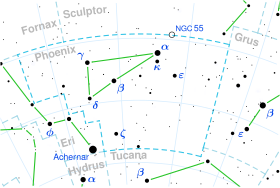
Summary
ι Phoenicis, Latinized as Iota Phoenicis, is a binary star[9] system in the southern constellation of Phoenix, near the constellation border with Grus. It is visible to the naked eye as a faint, white-hued star with an apparent visual magnitude that fluctuates around 4.71.[2] This system lies approximately 254 light years from the Sun based on parallax, and it is drifting further away with a radial velocity of +19.4 km/s.[4]
| Observation data Epoch J2000 Equinox J2000 | |
|---|---|
| Constellation | Phoenix |
| Right ascension | 23h 35m 04.57082s[1] |
| Declination | −42° 36′ 54.5409″[1] |
| Apparent magnitude (V) | 4.71[2] (4.70 - 4.75)[3] |
| Characteristics | |
| Evolutionary stage | main sequence[3] |
| Spectral type | A2VpSrCrEu[3] |
| U−B color index | +0.07[2] |
| B−V color index | +0.08[2] |
| Variable type | α2 CVn[3] |
| Astrometry | |
| Radial velocity (Rv) | +19.4[4] km/s |
| Proper motion (μ) | RA: +39.908[1] mas/yr Dec.: + 10.844[1] mas/yr |
| Parallax (π) | 12.8425 ± 0.3922 mas[1] |
| Distance | 254 ± 8 ly (78 ± 2 pc) |
| Absolute magnitude (MV) | 0.28[5] |
| Details | |
| Mass | 2.23[6] M☉ |
| Radius | 5.07+0.51 −0.42[1] R☉ |
| Luminosity | 68.2±3.3[1] L☉ |
| Surface gravity (log g) | 3.89[6] cgs |
| Temperature | 7,370+320 −350[1] K |
| Metallicity [Fe/H] | -0.01[7] dex |
| Rotational velocity (v sin i) | 23[6] km/s |
| Age | 573[6] Myr |
| Other designations | |
| Database references | |
| SIMBAD | data |
The primary component is an Ap star on the main sequence with a stellar classification of A2VpSrCrEu,[3] where the suffix notation indicates abnormal abundances of strontium, chromium, and europium in the stellar atmosphere. It is an Alpha2 Canum Venaticorum variable; its apparent magnitude varies from 4.70 down to 4.75 with a period of 12.5 days.[3] A rotationally-modulated magnetic field has been measured, varying from −72±9 G to 57±9 G. It has an estimated rotation period of 5.98±0.06 d, although this is in need of further confirmation.[10]
The proper motion companion[11] is a magnitude 12.8 star at an angular separation of 6.7″.[9]
References edit
- ^ a b c d e f g h Brown, A. G. A.; et al. (Gaia collaboration) (August 2018). "Gaia Data Release 2: Summary of the contents and survey properties". Astronomy & Astrophysics. 616. A1. arXiv:1804.09365. Bibcode:2018A&A...616A...1G. doi:10.1051/0004-6361/201833051. Gaia DR2 record for this source at VizieR.
- ^ a b c d Ducati, J. R. (2002). "VizieR Online Data Catalog: Catalogue of Stellar Photometry in Johnson's 11-color system". CDS/ADC Collection of Electronic Catalogues. 2237. Bibcode:2002yCat.2237....0D.
- ^ a b c d e f Samus, N. N.; et al. (2017), "General Catalogue of Variable Stars", Astronomy Reports, 5.1, 61 (1): 80–88, Bibcode:2017ARep...61...80S, doi:10.1134/S1063772917010085, S2CID 125853869, retrieved 2019-08-06.
- ^ a b Wilson, R. E. (1953). "General Catalogue of Stellar Radial Velocities". Carnegie Institute Washington D.C. Publication. Carnegie Institution of Washington. Bibcode:1953GCRV..C......0W. ISBN 9780598216885. LCCN 54001336.
- ^ Anderson, E.; Francis, Ch. (2012). "XHIP: An extended hipparcos compilation". Astronomy Letters. 38 (5): 331. arXiv:1108.4971. Bibcode:2012AstL...38..331A. doi:10.1134/S1063773712050015. S2CID 119257644. Vizier catalog entry
- ^ a b c d David, Trevor J.; Hillenbrand, Lynne A. (2015). "The Ages of Early-Type Stars: Strömgren Photometric Methods Calibrated, Validated, Tested, and Applied to Hosts and Prospective Hosts of Directly Imaged Exoplanets". The Astrophysical Journal. 804 (2): 146. arXiv:1501.03154. Bibcode:2015ApJ...804..146D. doi:10.1088/0004-637X/804/2/146. S2CID 33401607.
- ^ Gontcharov, G. A. (2012). "Dependence of kinematics on the age of stars in the solar neighborhood". Astronomy Letters. 38 (12): 771–782. arXiv:1606.08814. Bibcode:2012AstL...38..771G. doi:10.1134/S1063773712120031. S2CID 118345778. Vizier catalog entry
- ^ "iot Phe". SIMBAD. Centre de données astronomiques de Strasbourg. Retrieved 2019-08-06.
- ^ a b Eggleton, P. P.; Tokovinin, A. A. (2008). "A catalogue of multiplicity among bright stellar systems". Monthly Notices of the Royal Astronomical Society. 389 (2): 869. arXiv:0806.2878. Bibcode:2008MNRAS.389..869E. doi:10.1111/j.1365-2966.2008.13596.x. S2CID 14878976.
- ^ Sikora, J.; et al. (March 2019), "A volume-limited survey of mCP stars within 100 pc II: rotational and magnetic properties", Monthly Notices of the Royal Astronomical Society, 483 (3): 3127–3145, arXiv:1811.05635, Bibcode:2019MNRAS.483.3127S, doi:10.1093/mnras/sty2895, S2CID 119415579.
- ^ Frankowski, A.; et al. (March 2007), "Proper-motion binaries in the Hipparcos catalogue. Comparison with radial velocity data", Astronomy and Astrophysics, 464 (1): 377–392, arXiv:astro-ph/0612449, Bibcode:2007A&A...464..377F, doi:10.1051/0004-6361:20065526, S2CID 14010423



